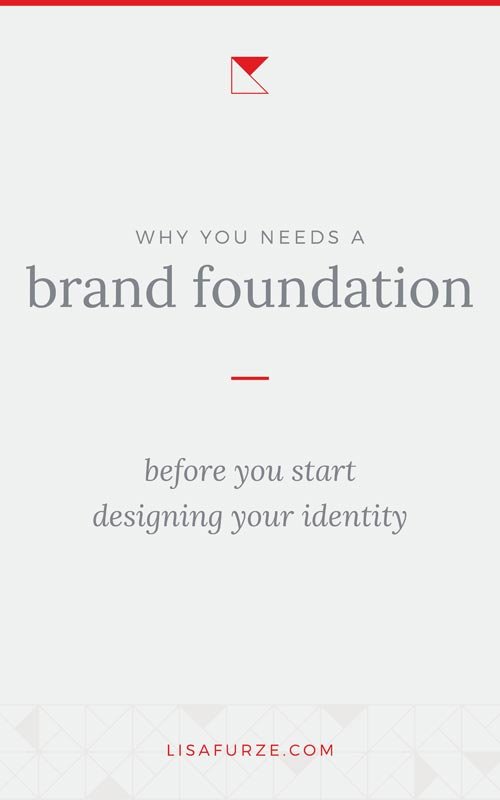 All right! You’re starting a business and you can’t wait to create a lovely logo, choose some colours. Pretty up your website. Awesome! I’m so excited for you!
All right! You’re starting a business and you can’t wait to create a lovely logo, choose some colours. Pretty up your website. Awesome! I’m so excited for you!
Buuut be careful not to dive in too early.
Every successful brand identity (which refers to the visual aspects of your brand, like logos, colours, photography etc.) is built on a strong foundation that sums up the driving force behind the business itself. That foundation is part of your brand too, and it’s an important part that actually directs how your brand should look.
You want your brand identity to have meaning behind it. You want substance behind your brand, not just superficial prettiness and empty promises.
So! I’ve broken up the concept of a brand foundation into three parts. Let’s take a look.
Brand Foundation Part 1: Purpose
This is the aim of your business. Your why. What do you hope to accomplish with your business? What kind of positive change do you want your business to make?
Not every business is out to dramatically change the world, but even small businesses should have a goal to improve people’s lives in some way. Whether it’s to save them time so they can spend a few more moments with their family. Or to make it easier to complete a certain task and save them some stress and anxiety.
Make sure you’re not just stopping at what you do — consider the reason behind it. It’s all about the WHY. Think about what you want your brand to be known for, and how will it become a part of people’s lives.
Also read: Defining a brand purpose that motivates your ideal client
Brand Foundation Part 2: Core Values
The values of your business will influence the way you conduct your business and the way you build your brand. Let’s say that one of your core values was environmental awareness, and leaving a small ecological footprint was really important to you. If that were the case, it would make sense for your business to use sustainable practices and make products that are easily recyclable. That kind of thing sets a strong tone for your brand — something you can build a community around.
Having core values helps your business to build trust and worth, which is so important when it comes to creating a successful brand. Along with the aims of your business, it creates a strong message (your brand message or mission statement — for more, check out this post) that gives your brand integrity, and helps it to stand out.
Some other examples of core values include:
- being adventurous in testing new ideas
- having total transparency in the way your business operates
- remembering to find the fun and joy in every task
- treating your clients like family
Also read: The essential guide to defining your core brand values
Brand Foundation Part 3: Brand Personality
It’s hard for people to feel connected to businesses. In fact, we’ve often been conditioned to feel somewhat wary and cautious about them. We know they exist to make money off us, so it can be difficult to trust the things they say.
By infusing your business with human characteristics, it makes it easier to engage with your audience. A brand with a sense of personality is much more relatable. It also allows people to instinctively understand whether or not a product/service has been created with them in mind. If they feel a connection, then they’re more likely to be the target market and become a part of your community. Consider how you want your customers/clients to feel.
When it comes to developing a brand voice, logo and imagery, being able to refer to certain personality traits also makes it a simpler task to stay cohesive.
Take the brand personality quiz!
 Last thoughts
Last thoughts
The visuals are often the first thing we notice about an exciting new brand. We see the visuals and think, “What a perfect, beautiful brand!”. What we have to realise though, is that the “perfection” doesn’t come from having pretty colours. It’s not the fact that the logo has just the right balance. Not even how lovely the lighting is in the photography.
It’s how all those things tell the story of the business. How it draws the right users in and shows them exactly what they can expect. That’s why you can’t design the way your brand will look before you know why it exists in the first place. It’s why a pretty logo doesn’t automatically mean your business will take off.
I hope this little guide helps you! It’s no easy feat to understand your “why”, or be able to fully define your values. But if you do, and you’re able to weave that foundation through your visual identity, your brand will be so much more successful.
For a more in-depth guide to coming up with your brand foundation, check out my free branding workbook. It’ll ask you the questions you should consider in the order you should consider them to come up with a meaningful foundation for your brand.
Looking for more content? Try these:
- What is brand culture all about and how do you build it?
- What is brand equity and what does it mean for small businesses?
- Brand strategy questions to ask when discovering your brand direction
- Should you hire a graphic designer for your small business?
- When it’s time to rebrand – signs your brand needs reviving
- How to use consistent branding to grow your business
